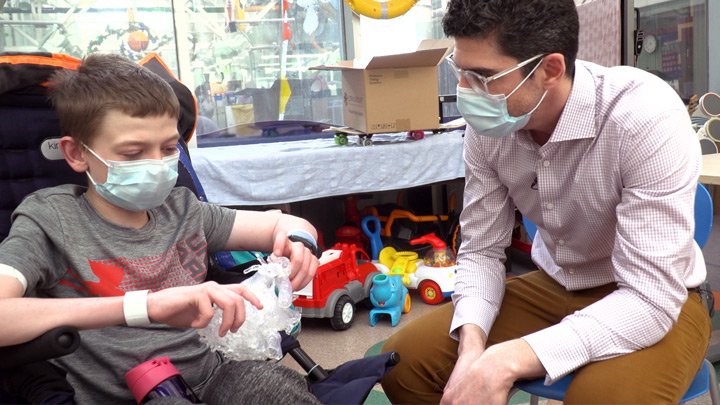
May 31, 2021

Brendan Ritchie and Dr. Charles Larson, a pediatric cardiac intensivist, check out a life-sized 3D model of Brendan’s heart.
Story by Marni Kuhlmann | Photo by Evan Isbister
Twelve-year-old Brendan Ritchie is surprisingly familiar with the ins and outs out his heart — quite literally.
He knows how small certain blood vessels are, and how large his pulmonary artery is, simply by studying a 3D model of his own heart — given to him by his care team at the Stollery Children’s Hospital to help him understand his pulmonary hypertension.
“It’s really an honour to actually be holding it in my hands, and really looking at it, and looking at what anomalies there are,” says Brendan. “It’s great that a doctor was wanting to do this for kids like me.
The life-sized 3D model of Brendan’s heart was printed through the Academic Technologies program in the Faculty of Medicine and Dentistry at the University of Alberta, in partnership with Brendan’s care team at the Stollery.
Brendan was diagnosed with pulmonary hypertension when he was just four-and-a-half-years-old, with no prior symptoms. “He fainted when we were walking, like three minutes from home. He said, ‘Daddy I’m tired’ and collapsed,” says his mom Kristine.
Pulmonary hypertension (PH) is high blood pressure in the arteries of your lungs, and sometimes also called pulmonary arterial hypertension (PAH). It’s a rare condition that exerts pressure on the right side of the heart — and forces the heart to work harder to pump blood through the lungs. It can happen to anyone, at any age, even to young children.
“It can often go undiagnosed an average of two years, and children often have very subtle symptoms such as shortness of breath and difficulty breathing,” says Dr. Angela Bates, a pediatric cardiac intensivist and pulmonary hypertension specialist. “They can have fatigue and they just don’t grow as well as other children.”
In Brendan’s case, PH caused the right side of his heart to become enlarged. Understanding why, with the help of the 3D model, helps to improve patient care.
“We tend to forget lists of things to watch out for, whereas having a visual and being able to understand what’s going on with your heart is much more powerful and much more memorable,” says Dr. Charles Larson, also a pediatric cardiac intensivist.
“It’s really important to understand what’s going on with your heart — and to understand why you need to come back for follow-up visits, what to look out for at home, and why you need to take your medications every day.”
To learn more about pulmonary hypertension, visit MyHealth.Alberta.ca.